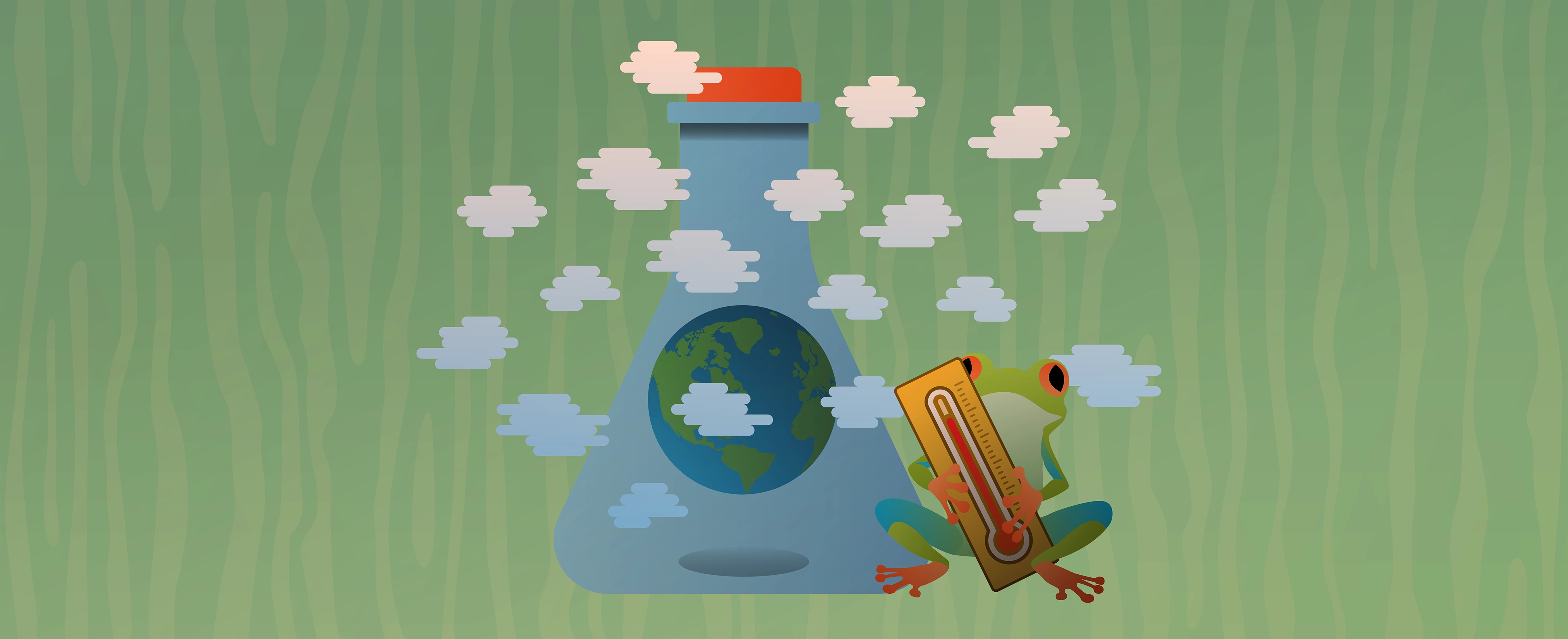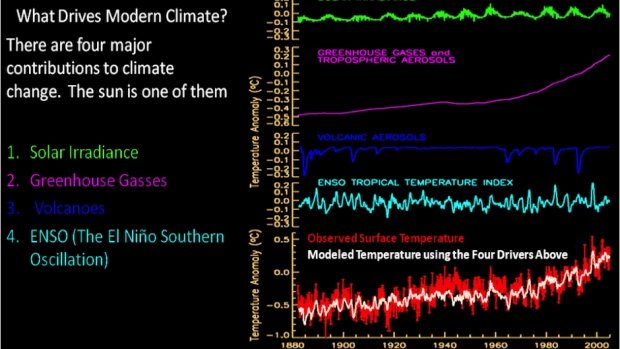Natural or Human-caused? How can you tell?
Why do more than 97% of climate scientists say that the global warming we are seeing today is caused by humans? How do they know whether storms and other climate events are the result of climate change? And how can they predict what will happen in the future?
Human or natural?
The climate (long term weather patterns) has always changed and there have always been long term trends towards warming or cooling over geological timescales that impact climate. Scientists were studying natural climate change long before it became the hot button issue it is today.
Using ice core, tree ring, and other data, they showed that the Earth has warmed and cooled many times in its past. They have also been able to show that there are natural phenomena that can alter climate, such as solar activity, volcanoes, orbital shifts as well as changes in atmosphere that can cause warming or cooling.

The greenhouse effect, which predicts that increases in atmospheric carbon dioxide and some other gases will trap the sun’s heat and make the earth hotter, was described in the 1800s, before there was any talk about human impacts. Government scientists in the 1940s and 1950s looked into the potential impacts of nuclear bombs on global warming. Scientists working in the fossil fuel sector predicted that carbon emissions from coal, oil, and gas would cause global warming as far back as the 1970s.
How do scientists know that those predictions have come true?
Why have they concluded that greenhouse gas emissions from fossil fuels account for the vast majority of the temperature increase? Because the data not only overwhelmingly shows a relationship, but the evidence also rules out natural causes.
Much of the data and analysis is available for people to dig into, though, it is not always readable for the average person. Based on the patterns observed for forces other than greenhouse gases, the temperature would not be increasing over the last few hundred years.
Here is another depiction of the various potential influencing forces on global temperature showing not just the correlation between greenhouse gases and rising temperatures, but also the lack of correlation, or even cooling effect of other radiative forces.
And a more detailed view of the relationship between carbon dioxide emissions and temperature, one that is predicted by models more than 50 years ago:
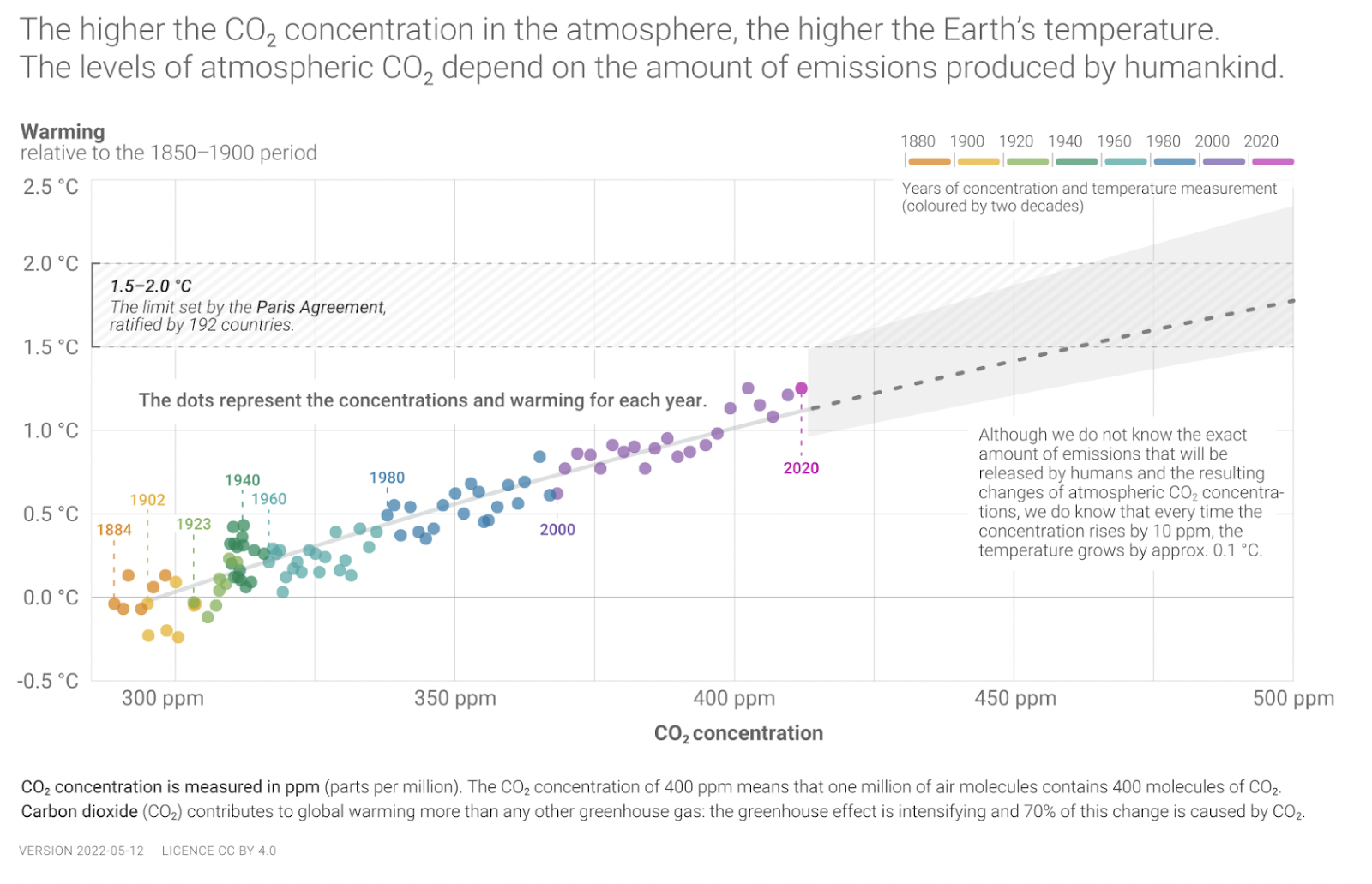
Looking further back, we can also see that we are in uncharted territory with respect to the atmospheric carbon levels humans and other species today have ever been exposed to.
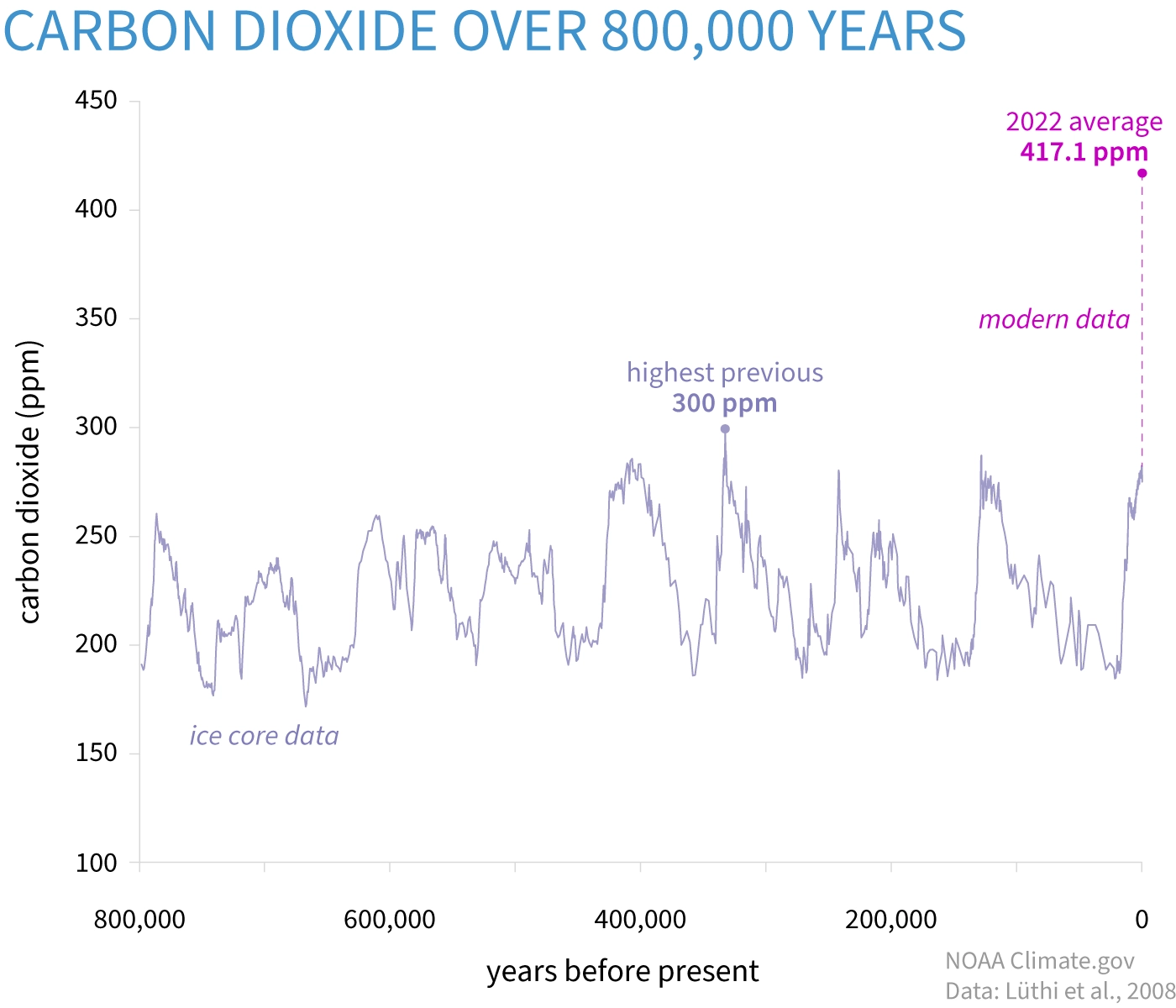
Atmospheric carbon dioxide (CO2) in parts per million (ppm) for the past 800,000 years based on ice-core data (light purple line) compared to 2022 concentration (bright purple dot). The peaks and valleys in the line show ice ages (low CO2) and warmer interglacials (higher CO2). Throughout that time, CO2 was never higher than 300 ppm (light purple dot, between 300,000 and 400,000 years ago). The increase over the last 60 years is 100 times faster than previous natural increases. In fact, on the geologic time scale, the increase from the end of the last ice age to the present (dashed purple line) looks virtually instantaneous. Graph by NOAA Climate.gov based on data from Lüthi, et al., 2008, via NOAA NCEI Paleoclimatology Program.
And the last time that temperatures were above what we are seeing today was 125,000 yrs ago.
We are not adapted for the future we are running towards. And we certainly didn’t build our societies for the climate we are creating.
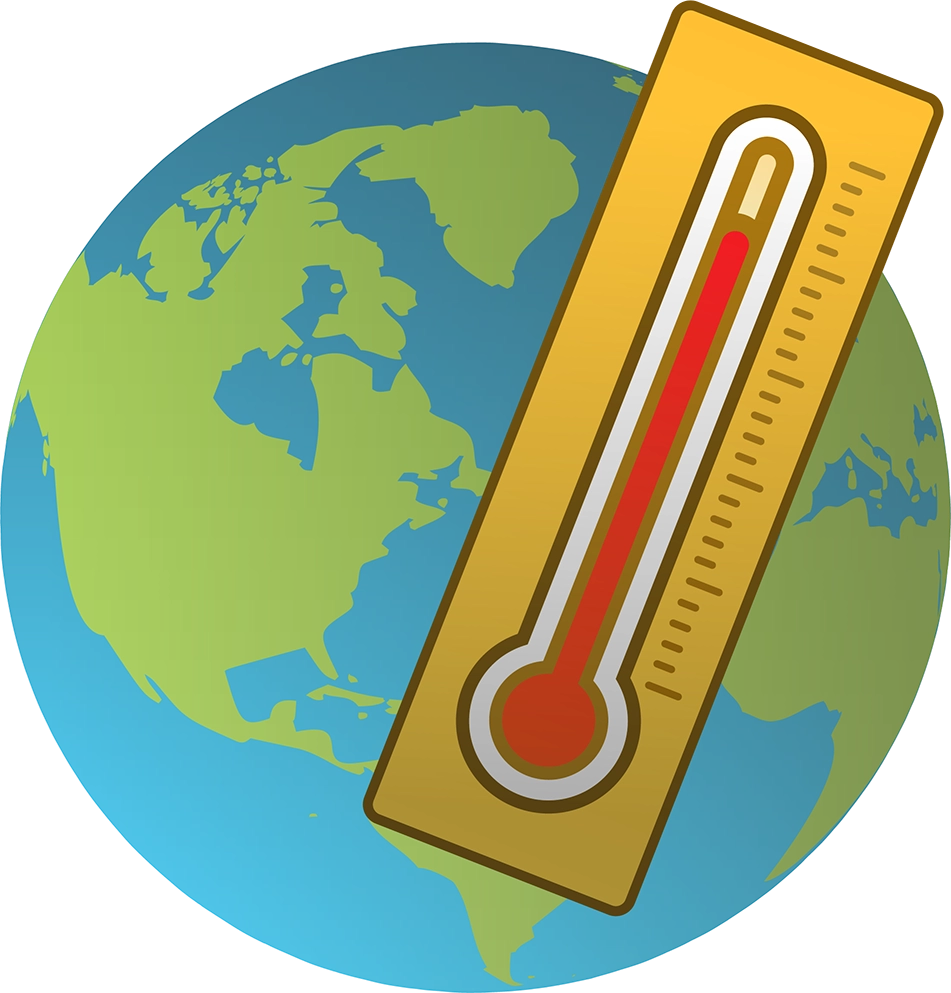
Severe weather events, droughts, and wildfires — which are started by humans or lightning but spread due, in part, to hot/dry weather conditions — have been happening forever and not every recent disaster can be attributed to global warming.
It is not a straightforward and simple task to determine whether weather events and other climate disasters like wildfires and droughts are actually a result of increased average global temperatures and its impact on weather systems and local climate. That is in part, why climate scientists have been so cautious in their language over the last few decades as the modelling, monitoring, and measurement systems became increasingly sophisticated and accurate.
The consensus and confidence among scientists now, is also the reason that we should be concerned about the seriousness of the crisis and the impacts of climate change on weather-related disasters.
Attribution science for climate change is conceptually similar to attribution science of, for example, the ties between lifestyle variables and risk of cancer. If you believe in the science that shows how certain diets and other lifestyle factors can increase your chances of getting cancer, then you have some confidence in attribution science. And because data collection and model sophistication has improved over time, scientists are now confident in their ability to determine the probability that climate change has increased (or decreased) the likelihood or severity of an event or the frequency of climate disasters in a region or timeframe.
CarbonBrief — Attributing extreme weather to climate change
Note: You can link a list of each referenced attribution study through this site.
Climate Signals — Science Sources: Detection and Attribution
Note: This site lets you search for attribution studies.
Clean Energy Canada has also compiled a list of the research showing the relationship between climate change and Canadian wildfires, heatwaves, floods and storms.
Note that climate change is implicated in many heat waves, heavy rain, drought, wildfires, cyclones, hurricanes, flooding and landslides, flash floods but it is not thought to impact earthquakes, tornadoes, or volcanic eruptions based on the current evidence (though the latter can impact temperatures in the short term).
Overall, the research indicates that climate change increases the likelihood, severity, and/or frequency of severe weather and other climate events. See specific results of the research in Why So Urgent?
Finally, it is through the synthesis of tens of thousands of peer-reviewed research papers including observed changes, experimental changes, robust datasets from many sources, and sophisticated climate modelling across multiple independent labs across the globe that scientists have developed predictions and confidence in each prediction for what the future will look like.
The synthesis of this research is available in the IPCC reports and there are many analyses and papers that are available for public review. Some are referenced in the Why so Urgent? section of this site.
Greenhouse gas emissions, largely from the burning of fossil fuels, are causing the changes in climate that we are seeing today.
References
1. NOAA. (n.d.). Space weather impacts on climate. NWS Space Weather Prediction Center. https://www.swpc.noaa.gov/impacts/space-weather-impacts-climate
2. The Economist Newspaper. (2024, January 12). Eight charts illustrate 2023’s extreme weather. The Economist. https://www.economist.com/graphic-detail/2024/01/12/eight-charts-illustrate-2023s-extreme-weather
3. Lindsey, R. (2022, October 12). How do we know the build-up of carbon dioxide in the atmosphere is caused by humans?. NOAA Climate.gov. https://www.climate.gov/news-features/climate-qa/how-do-we-know-build-carbon-dioxide-atmosphere-caused-humans
4. Scott, M. (2014b, September 17). What’s the hottest earth has been “lately”? NOAA Climate.gov. https://www.climate.gov/news-features/climate-qa/what%E2%80%99s-hottest-earth-has-been-%E2%80%9Clately%E2%80%9D

